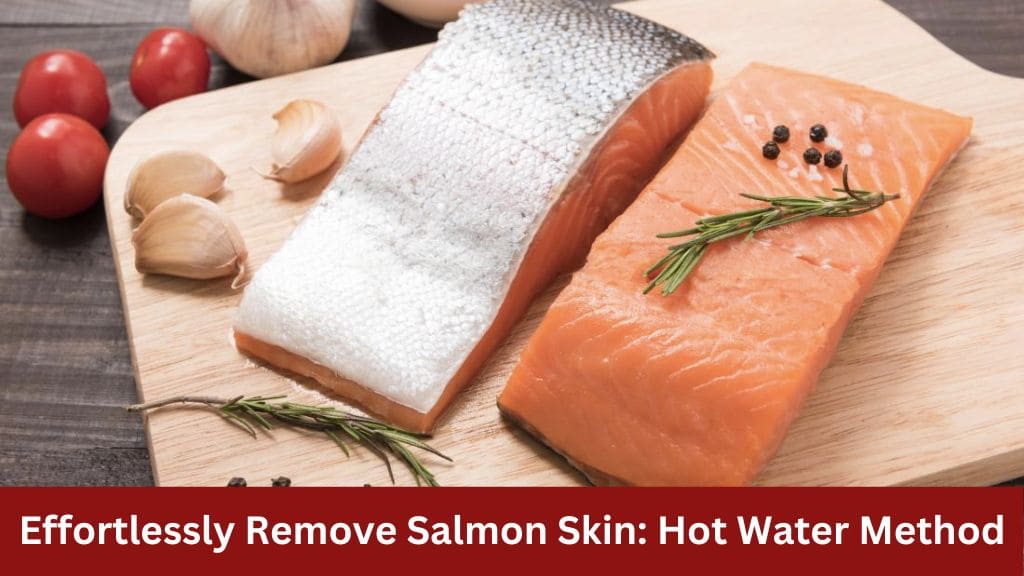Salmon is a popular choice for many meals due to its delicious flavor and numerous health benefits. However, dealing with the skin can be a daunting task for some home cooks. Fortunately, there’s a simple and effective method for removing the skin using hot water. In this comprehensive guide, we’ll explore the step-by-step process of removing salmon skin with hot water, along with tips and tricks for perfecting this technique.

Removing the skin from salmon can be challenging, especially if you’re not familiar with the process. Traditional methods often involve using a knife, which requires precision and skill to avoid wasting precious meat. However, using hot water to remove salmon skin offers a hassle-free alternative that yields excellent results.
Why Use Hot Water?
Hot water is a gentle yet effective way to loosen the bond between the salmon skin and flesh, making it easier to remove without damaging the meat. Unlike using a knife, which can result in uneven cuts and wasted flesh, hot water provides a more uniform and controlled approach to skin removal. Additionally, this method is suitable for both novice and experienced cooks, requiring minimal equipment and expertise.
The Step-by-Step Process

1. Gather Your Ingredients and Equipment
Before you begin, ensure you have all the necessary ingredients and equipment at hand:
- Fresh Salmon Fillets: Choose high-quality salmon fillets with the skin on. Freshness is key for optimal flavor and texture.
- Boiling Water: Heat water until it reaches a rolling boil. You can use a pot on the stovetop or a kettle for convenience.
- Baking Rack: Select a sturdy baking rack that fits over a casserole dish or tray. This will elevate the salmon and allow the hot water to drain away.
- Casserole Dish or Tray: Place the baking rack over a casserole dish or tray to catch any drips or spills.
2. Prepare Your Workstation
Set up your workstation by placing the baking rack over the casserole dish or tray. This setup will create a stable platform for the salmon fillets and prevent any messes on your countertop.
3. Position the Salmon on the Rack
Lay the salmon fillets skin-side up on the baking rack. Ensure that they are spaced evenly and not overlapping to allow for even exposure to the hot water.
4. Boil the Water
Heat water until it reaches a rolling boil. You want the water to be hot enough to effectively loosen the skin from the flesh without overcooking the salmon.
5. Pour the Hot Water Over the Salmon Skin
Carefully pour the boiling water over the salmon skin, ensuring that it covers the entire surface of each fillet evenly. The hot water will start to work its magic, loosening the skin from the flesh.
6. Allow the Salmon to Rest
After pouring the hot water, allow the salmon to sit for approximately 1-2 minutes. During this time, the heat from the water will continue to soften the skin, making it easier to remove.
7. Remove the Skin
Using a pair of tongs or your fingers (if the salmon has cooled down enough), gently peel the skin away from the flesh. Start at one corner of the fillet and work your way across, taking care not to tear or damage the flesh.
8. Serve and Enjoy!
Once the skin has been successfully removed, your salmon fillets are ready to be cooked or served according to your recipe of choice. Whether you’re pan-searing, grilling, or baking the salmon, you’ll now have tender, skinless fillets ready to enjoy!
Tips for Success

1. Use Fresh Salmon
Freshness is paramount when it comes to selecting salmon for this method. Look for fillets with firm flesh, vibrant color, and a pleasant oceanic aroma. Avoid salmon that appears dull, discolored, or has a strong fishy smell, as these are signs of age or deterioration. Choosing fresh salmon ensures optimal flavor, texture, and overall quality in your final dish.
2. Don’t Overheat the Water
While hot water is essential for loosening the skin, it’s crucial not to overheat it. Water that is too hot can overcook the salmon, resulting in a loss of moisture and a less desirable texture. Aim for water that is at a rolling boil but not boiling vigorously. This temperature range effectively softens the skin without compromising the integrity of the flesh.
3. Be Patient
Patience is key when using hot water to remove salmon skin. Allow the hot water sufficient time to work its magic and soften the skin before attempting to peel it away. Rushing the process may result in torn or damaged flesh, so resist the temptation to hurry. By giving the hot water a few minutes to penetrate and loosen the skin, you’ll achieve cleaner and more consistent results.
4. Practice Proper Safety
Working with hot water requires caution to prevent burns or scalds. Use oven mitts or kitchen towels to handle hot pots, kettles, or baking racks. Avoid splashing hot water onto yourself or others, and be mindful of steam when pouring the water over the salmon. Safety should always be a top priority in the kitchen, so take care to protect yourself and others from potential hazards.
5. Experiment with Flavors
Once you’ve mastered the basic technique of removing salmon skin with hot water, don’t be afraid to get creative with flavors. Consider marinating the salmon before cooking or seasoning it with herbs, spices, or citrus zest to enhance its taste. You can also explore different cooking methods, such as grilling, broiling, or smoking, to add depth and complexity to your dish. Experimentation is part of the fun of cooking, so let your creativity shine and tailor your salmon recipe to suit your personal preferences.
Conclusion
Removing salmon skin with hot water is a simple yet effective technique that can elevate your cooking skills and enhance your dining experience. By following the step-by-step process outlined in this guide and incorporating our tips for success, you’ll be able to effortlessly remove the skin from salmon fillets with confidence and ease. Say goodbye to tedious knife work and hello to perfectly skinless salmon every time!





